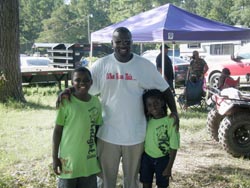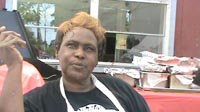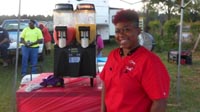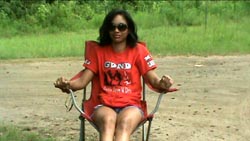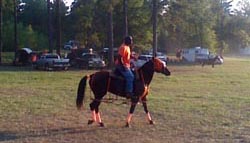Riding Clubs in Northwest Louisiana Serving as Mutual Aid Societies
By Rolonda Teal

According to club members, African American riding clubs emerged during the 1970s in Northwest Louisiana. While the origins of these events are unclear, it can basically be said that the clubs formed from a commonality around horses. According to Mrs. Jeri Burrell, "Horses are just like children. You find pleasure in horses. If you have something on your mind and you get on a horse's back and ride two or three miles down the road–Peace, Peace. It gives you peace of mind, enjoyment" (Burrell 2007). Perhaps it is Ms. Burrell's statement that attracted people to initially form riding clubs, but it may also have been because of a long tradition of African Americans working with horses in the region. Images from the 1940s at Magnolia Plantation in Natchitoches Parish clearly demonstrate that young African American men performed stunts and trick riding while on horses. Prior to that time, it was often African American male youth who held occupations as stable boys; and men who were responsible for breaking horses and training them for races.
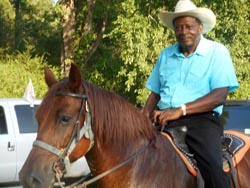
Mrs. Joy Ellis-Walters is a second generation riding club member. Her father, Joe Ellis, formed the Apache Riding Club in the mid-1960s which was one on the first clubs created by African Americans in Northwest Louisiana. Other early clubs were the Rough Riders from Shreveport, the Outlawz of DeSoto Parish, and the Cooper Road Club out of Shreveport. Ms. Ellis-Walters' daughters, Daryl and Darylon, constitute the third generation of riders both of whom are members of the Nationwide club. Ms. Ellis-Walters remembered when she was a child, she and her father rode with some of the old-timers like Roosevelt Hicks, Eugene Calhoun, and Freddie Hines, all of whom still ride with the exception of Mr. Hines who passed recently. Ellis-Walters also remembered a time when the club events were more like a rodeo. According to Ellis-Walters, "At the time, see we only had one rodeo up here and that was Apache Riding Club and they would have it . . . about once a month. Then the other weeks we would go to other people's [events] (Ellis-Walters 2016). Other things that she recalls is how much the new generation clubs have changed from the earlier ones. Some clubs have changed names although the members are the same. For instance, the Motown Riders are now the Pony Express Riders. During those formative days, people tended to ride Quarter Horses but today there are lots of Tennessee Walkers, Shadow Horses, and Pacers. Aside from name changes and the loss of rodeo-type activities, the riding clubs still serve a basic function which is to provide a place for socialization that stems from a love of horses.
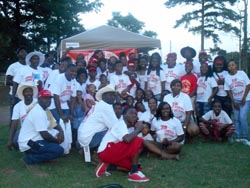
Whatever reasons lead to the creation of clubs, since the 1970s their numbers have grown. New clubs are created each year as is the case with the "318 Ghost Riders." This club lead by Raymond Smith held its first riding event in June and it was a huge success for first-timers. As with the majority of clubs, they are organized through a governing board that directs the actions of the club. The board for the 318 Ghost Riders is comprised of family members and includes positions such as vice-president, secretary, treasurer, horse trainer, and a public relations person. Although a new club, they boast of a membership of over 70 people. At their June 25th event, there were several clubs present, food, and beverage vendors; a hay wagon; and a place for dancing. This scene is typical of most trail ride events; in fact, the only thing missing was RV's for overnight camping. At some events, people are allowed to spend the night, generally because of the distance they have traveled. Sometimes they camp simply because this is the only opportunity they have to do so. Generally, camping opportunities are available when the event takes place on private land.
A few of the clubs own land on which all of their events are held. As a courtesy and as a means to generate funds, the private land is also made available for other clubs to rent. For instance, the Hines Brothers Barn was rented by the 318 Ghost Riders for their event. This is a popular rental space for clubs that do not have a regular place to meet. The Big W riding club in Grand Cane is another such spot and is sometimes used for family reunions. On average the club rents the land for the weekend at a rate of $800 to $1,000. This cost is often offset by fees that are collected at the entrance gate and proceeds from vendors. Entrance gate fees vary by club with some charging $5.00 per person while other clubs charge $10.00 to $15.00 by the car load. Most often children under the age of 10 are admitted for free.
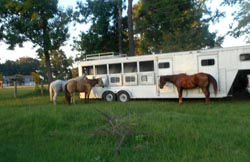
On a Saturday evening in 94-degree weather, the club began its trail ride which was to consist of only five miles due to the extreme heat. Normally, the club would ride for about 15 miles. The trail ride itself has multiple purposes: members get a chance to actually ride with a group, people along the route often come outside their homes to watch the riders just like watching a parade, and those who are unable to ride for whatever reason are still able to participate by climbing on board the hay wagon. At about the half-way point of this and every other ride, the horses were given a rest period. The riders dismounted, walked around, and mingled with others. When possible, the horses were given water. After about 30 minutes the ride continued as folks sought their way back to the starting point. Once the group returned, horses were tethered to trailers, trees, and fences while the riders went on to enjoy other activities.
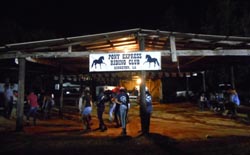
Many of the youth chose to go to the dance floor which stayed busy until the night officially ended. Almost every club has a dance on Friday or Saturday night of the event if not both nights. Sometimes a DJ is hired, at other times music is piped in via an Ipod, smart phone, or computer.
Some of the adults went to the vendor's booth for refreshments. One such vendor was E&M Southern Catering which is operated by Emma Manigo and her son Marshall Manigo. This business has existed for 15 years and not only participates in riding club events but also in weddings, baby showers, and birthday parties. Over the years they have traveled to Austin, TX, Plain Dealing and Minden, LA, and other places that riding clubs are hosting events. Ms. Manigo states that typically clubs invite vendors to participate in their event. She can either accept or decline the invitation at that time. Unless there are other scheduled catering events, she will typically accept the invitation.
Perhaps, part of the reason she receives invites is due to the menu she provides. E&M Southern Catering serves, "Southern fried catfish, jumbo shrimp, [and] funnel cake" (E. Manigo 2016). The menu changes, however, depending on where they travel and what the club wants. The catering business is a part-time job for Ms. Emma which she does simply because she likes cooking. Her son, Marshall works as a trucker during the week, but on the weekends if his mother needs him then, he can be found in the booth with her. His role with the company is primarily as the funnel cake cook, however, should his mother one day retire, he sees himself running the business. Although Marshall is not a riding club member he feels everyone should come out just to experience a ride. He cites food, dancing, hay rides, horse riding, and a sense of family as the reasons he finds the events enjoyable even for non-members.
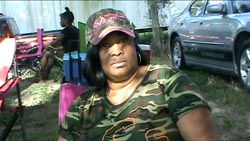
After drinking a complimentary glass of home-made lemonade from Ms. Emma, I spoke with Ms. Yolanda Jackson who is a member of the JCS Riders of Minden, LA, that formed in 2011. Prior to becoming a JCS rider, she belonged to the LA Renegades which started about 30 years ago by some of her family members from Frierson, LA. Ms. Jackson enjoys belonging to a club because they focus on family and children. Although there are many aspects of the club she could focus on, Yolanda has chosen to concentrate on children's entertainment. In 2016 at this writing, her club will host a Kiddie Land on Halloween weekend. She intends to have "bounce houses, . . . cotton candy, and snow cones for them." Ms. Jackson believes the riding events when she was growing-up, helped to keep her and others out of trouble and also gave them something to look forward to on the weekends.
Many of the clubs begin their riding season in January with a "Warm-up" ride. This provides club members a chance to get their horses ready for the big ride to Houston where riders participate in the annual Houston Livestock and Rodeo Show. As said by Ms. Burrell, the Houston ride begins in Logansport, LA, where approximately 1,000 riders gather from Northwest Louisiana. They travel south to either Livingston or Beaumont, TX, and from there on into Houston. This is typically a week-long ride so riders camp out in tents and RVs each night. All the cooking is done collectively for the whole group with different clubs taking responsibility for meals each day. A day concludes after about 10 hours of riding.
Prior to the warm-up ride, preparations for the horses' safety becomes paramount. They are sometimes given a different diet than usual to help with physical endurance. The horses are ridden more frequently also to build endurance and they are given new shoes. The art of horse shoeing is only practiced by a few people these days. One such person is Amard Babers who lives in Campti, LA. By day, Mr. Babers works for the City of Natchitoches but in the evenings and on weekends, he shoes horses for people from Natchitoches, Winn, DeSoto, and Caddo parishes. According to Amard, he began shoeing because,
I was at home one day, me and . . . my daddy say, "Did the guy show up to shoe the horse?" I say, "No." I got frustrated and say, "I'm going to shoe my own horse." One day, had some shoes layin' around somewhere, and a friend of mine let me borrow some of his tools. I was nervous, and said, "I'm just going to take a chance," and I nailed my first shoe on my first horse and I've been doin' it ever since then. . . . As the years went on, I learned from different other people. Some things I did know, but you don't know everything, and you never get too old to learn. I've gotten more advanced with a lot of things, and I'm thankful for a lot of people [like] Mr. Carl Hudson and Ocie Charles, Bernard D. Martin, and Mr. Willie Davis (Lee and Teal 2015).
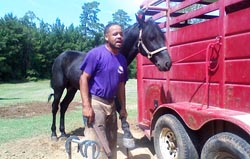
Just as Mr. Babers has a specialized skill that contributes to the overall functioning of riding clubs so do other club members. For instance, Larry Brokenberry is a horse trainer for the Louisiana Downs horse racing arena in Shreveport. Mr. Brokenberry is responsible for planning training exercises, breaking horses to saddle, and desensitizing horses to unfamiliar sights and sounds (Kramer 2016). Finally, there are people like Vincent Smith who teaches newcomers how to ride horses. In his club, there were several members who not only did not own horses but had never ridden one alone. Now, he can count on one hand the number of members who have no familiarity with horse riding.
A week after the 318 Ghost Riders event, the "Pony Express Riders" held their event. This group formed in 1977 and is headed by brothers Larry and John Brokenberry. While most clubs follow the same basic format, the Pony Express Riders differ in that on Friday night there was a calf-roping event, a calf scramble, and a scheduled barrel-racing component that did not occur, but is typically part of this club's activities. During the calf-roping, a single calf is placed in one stall while a rider on horseback is in the next stall. A person opens the gate for the calf to run out while simultaneously opening the gate for the rider. The objective is to catch the calf with a rope before the calf exists the arena. Mr. Cornell Rasberry also known as "Tank" used a cattle prod to coax the calf out of the stall. A few calves were caught, but most got away. Arguably, the most exciting part of the rodeo was the calf scramble in which children about 12 years and younger tried to pull a rope from a calf's tail. There was lots of running and laughing and near catches but no one won the money prize that night. As a reward for good effort, Larry Brokenberry treated each child participant to free sodas. As some of the children passed me on their way to get the soda, they could be heard explaining to each other why they missed pulling the rope and what they would do differently the next time. The Pony Express Riders is one of the few remaining clubs that offer rodeo components.
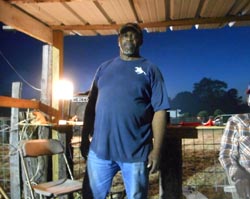
It was at the Pony Express Riders event that I met Mrs. Ellis-Walters and her daughter Daryl. Daryl is the public relations person for the Nationwide Riders. Her club, like most others, help the community in which they are connected by providing one or more of the following services: educational scholarships, financial help with illnesses, burial assistance, as well as conducting fundraisers for organizations such as Shriner's of America, Southern University Agricultural Department, and St. Jude Children's Hospital. Mrs. Burrell's club gives three annual scholarships in the amount of $1,000 each. In addition, the Independent Riders host a fundraiser for St. Jude each June. According to Mrs. Burrell, "most of our money is given back to the community one way or the other."
While riding clubs are virtually independent groups, generally with a small membership, they still belong to a larger group known as associations. Associations are made-up of no more than 25 riding clubs and extend throughout the state. For example, there is the Central Louisiana Association that consists of approximately 23 clubs. John Babers, president of the LA High Steppers Riding Club of Natchitoches, LA and his group joined the Central Association in 1987. In 1991, they also joined the Piney Woods Association of Lufkin, Texas. The Independent Riders are part of the Northwest Association as are the Big "W" Renegades and Just Ride clubs. In order for a club to become part of an association they must be in existence for a minimum of two years, then get on a list and wait for an opening. The advantages of small groups coming together as a larger one is perhaps best summarized by sociologist W. E. B. DuBois (1898) when he wrote about mutual aid-type societies, "These smaller and more compact groups do not handle as much money as the churches, but by arranging regular sources of income and carefully calculating expenses they use their funds more effectively." Although associations were not part of the 1970s clubs, they are very much a part of the Gen X culture with some associations having clubs that join from multiple states.
Riding clubs, it appears, have replaced the role of groups like the Freemasons and Elks. Historically, in most African American communities, secret societies have played a part in the community's development by often times taking on the role of mutual aid societies after their collapse. Groups like the Freemasons helped build churches and schools within black communities. The first recognized group that fits this description was the Free African Society which began in 1787 in Philadelphia under the leadership of Absalom Jones and Richard Allen. Jones and Allen led a succession from the Methodist Church to create the society whose stated purpose was to "support one another in sickness and for the benefit of their widows and fatherless children" (Frazier 1964:41). Although the Free African Society originally formed in part through the Methodist Church, by the late 1800s, the concept had extended to Baptist congregations throughout the South. Within a few decades, clubs formed bearing names such as The Order of the Eastern Star, House of Ruth, and Mosaic Templars of America to name a few. These societies were so popular that DuBois observed their importance:
Next in importance to churches come the Negro secret societies. When the mystery and rites of African fetishism faded into the simpler worship of the Methodists and Baptists, the secret societies rose especially among the Free Negroes as a substitute for the primitive love of mystery. Practical insurance and benevolence, always a feature of such societies, were cultivated. Of the organizations reported ninety-two were secret societies —some, branches or imitations of great white societies, some original Negro inventions. (DuBois 1898:5)
What the organizations, with their varied names, seemed to have in common is: some element of secrecy, a collective responsibility for the care of their community, kinship and/or geographic ties, and influence over the social and moral behavior of its members. Educator Booker T. Washington, a member of Mosaic Templars of America, felt the organization essential enough to the development of the black community that he declared he had joined because, "it seemed unnatural that a Negro should not belong to some kind of order" (Washington 1911:39).
Membership in secret societies such as the Masons began to decline by the early 1960s while the Elks Lodges began losing members in the 1980s (Hamilton 2010). It could be a coincidence that riding clubs began forming around this same time, however, it is equally possible that the clubs formed in order to replace the declining interest in the more established lodges. The riding clubs were able to do what the lodges had done, which was to create ways to care and provide for the community on both an individual and collective level. E very riding club can be linked to a specific region or community. For instance, the Pony Express Riding Club hails from Kingston, LA, while the 318 Ghost Riders are from Mooringsport; the Gettin Down N Dirty group comes from the combined states of Texas, Louisiana, and Arkansas; and the No Limit club originates out of Haughton. In this way they are similar to mutual aid groups whose various lodge names indicate the general location of group members. In a study of Mosaic Templars of America (MTA) headstones conducted in Natchitoches Parish, it was discovered that each MTA grave marker identified the community name associated with the deceased. Whether the community name is where the person was raised or where they joined the society is unclear, however it can be determined that the deceased were, in some way, connected with a community. For instance, the Happy Home Chamber was in Cypress, LA, the Sunshine Chamber in Rockford, and the Little River Chamber was in Nolia —a community that no longer exists (Teal 2006).
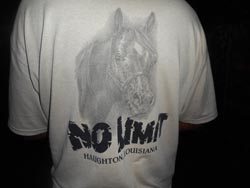
Since MTA members belonged to specific chambers that were associated with specific towns and communities, in many instances the members were related along kinship lines. Mrs. Ellis-Walters belongs to the same club as her two daughters. Larry Brokenberry has children and grandchildren who are part of the same club. Raymond Smith of the 318 Ghost Riders when asked how many of his members were related, responded, "all of 'em." In essence, the clubs are comprised of family members or people who live in the same general area. Even if a member moves to another state, they can still hold membership in that club simply by paying annual dues. Clubs then create a way for family members to have a psychological connection with a region and with each other regardless of distance. The dues vary depending on the club and can range from no fees, to a few dollars per month, to a couple of hundred dollars per year.
Regional location does not interfere with club membership nor does gender. There are no all-male or female rides. There are no board positions within the clubs that can't be held by either gender. There are no gender rules on who can own or ride a horse. In, fact, the only difference observed along gender lines was the discovery of a club that was founded and named in honor of Shitaka, a woman who is now deceased. C. Rushing said that the "Sweet Riders" club was "formed eight years ago, which would be 2008. My daughter, Shitaka Waldrup, she come up with an idea we needed our own club so we come up with the Sweet Riders. . . . It was so many clubs that we just couldn't pick the right one so we decided to have one of our own. And my daughter is deceased, but we still keep it going" (Rushing 2015). There may be other clubs named in honor of a deceased loved one, or perhaps in honor of a girl or woman; however, this type of gender difference represents something positive.
Once a person becomes an official member of a club, they are given a nickname that symbolically represents acceptance in the club. The nickname can be chosen by the person and reflects how they want to be addressed but most commonly, nicknames are given by another club member. If the name sticks, then everyone in the clubs begins to refer to that person by the new nickname. Examples of nicknames are "Cowboy" for Mr. Willie Dixon, "Sassy Creole" for Ms. Dishika Lloyd, and "Billy Coon" for Mr. Larry Brokenberry. Not only do nicknames indicate club acceptance but they also are used as terms of affection amongst members and usually depicts some characteristic of the member.
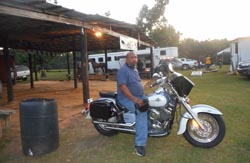
A final observation of the clubs is that although this article is about horses, there are some clubs that focus on motorcycle riding. Often times the two groups meet to support one another with events. Although I did not see a strong showing of motorcycles at either of the events I attended; I was able to speak to a couple of people who shared that motorcycle clubs sometimes arrive with 20 to 50 members. During the Pony Express ride, there was one cyclist present whose name is Dan Harmon. Mr. Harmon does not belong to a club, however, he enjoys attending social events where people are gathered simply to have fun. It appears that those people who do not enjoy horses can still participate in activities by riding motorcycles and achieve the same level of comradery.
With the expansion of riding clubs and changes in activities provided, it is likely that an increased understanding of their role and function in African American culture will need more extensive studies. But, for now it can be said that the clubs are replacing fraternal organizations, that they focus on family and community, and that they represent a fun gathering spot. Ms. Jackson perhaps best summarizes the importance of the clubs in her life with this comment:
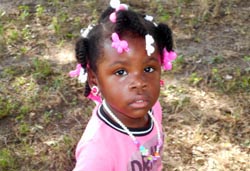
You see all the negativity, the violence that's going around. So, for me, I want to keep it about family because to me that's what saved us. We had something to do. We had something to look forward to do with our parents on weekends. So, you don't have to send yours kids off to a babysitter while you go to the night club. You can actually bring your kids out here with you.
Ms. Jackson's explanation is probably applicable for many families that participate in riding clubs. Nearly everyone I spoke with encouraged me to inform the public about their existence and invite them to come out and participate in their functions. So, on behalf of the clubs —Come on Out and Celebrate!
Sources
Babers, A. personal communication, November 3, 2015.
Babers, J. personal communication, April 14, 2015.
Burrell, J. personal communication, February 2, 2007.
Carroll, T. personal communication, July 1, 2016.
DuBois, W. E. B. (Ed.). (1898). Some efforts of American Negroes for their own social betterment (No. 3). Atlanta University Press.
Ellis-Walters, J. personal communication, July 1, 2016.
Frazier, F. E. (1964). The Negro Church in America. Liverpool University Press.
Hamilton, C. (2010). Fraternal reorder: Clubs, lodges face dwindling membership in modern world. Lawrence Journal World. Retrieved from http://www2.ljworld.com/news/2010/jan/10/fraternal-reorder/.
Jackson, Y. personal communication, June 25, 2016.
Kramer, M.H. (2016). Racehorse Trainer. Retrieved from http://animalcareers.about.com/od/Equine/a/Horse- Groom.htm.
Lee, D. and Teal, R. (2015). Oral History and Ethnographic Interviews with Traditionally Associated People of Cane River Creole National Historical Park. Cane river Creole National Historical Park Collection, Natchitoches, LA.
Lloyd, D. personal communication, July 14, 2016.
Manigo, E. personal communication, June 25, 2016.
Manigo, M. personal communication, June 25, 2016.
Rushing, C. personal communication, April 14, 2015.
Smith, R. personal communication, June 25, 2016.
Teal, R. D. (2006). The deepest secrets of our hearts shall be made known: A comparative analysis of the socio-religious practices of Gullahs in South Carolina and African Americans in Natchitoches, Louisiana. (Unpublished thesis). University of Houston, Houston, TX.
Washington, B. T. (1911). My larger education: Being chapters from my experience. Doubleday.


